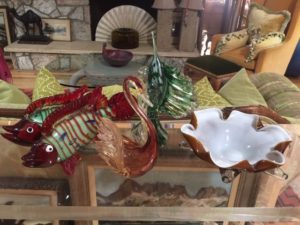 You can buy hundreds of Murano glass clowns, all with bright colors and comical expressions, handmade on the island of Murano, Italy. But they will cost you. Here’s some famous clowns that might amuse: Happy the Snowman, Binky, Play Poker, Ballsy (he’s holding a ball – lest you think otherwise), Bombolo, Boozy, Bongo…. Well, you get the picture; $800-1,000 each. But you have a mid century Murano clown? What’s that ugly thing worth?
You can buy hundreds of Murano glass clowns, all with bright colors and comical expressions, handmade on the island of Murano, Italy. But they will cost you. Here’s some famous clowns that might amuse: Happy the Snowman, Binky, Play Poker, Ballsy (he’s holding a ball – lest you think otherwise), Bombolo, Boozy, Bongo…. Well, you get the picture; $800-1,000 each. But you have a mid century Murano clown? What’s that ugly thing worth?
Collectors showcase online an entire cabinet of such ludicrous figures. JT sent me five-pieces of mid-century figures: two fish, a bowl, a swan and a swordfish. “Does anyone like these? Do they sell? For how much?” She asked.
Murano Glass figures Worth More Than Others
The good pieces aren’t whimsical clowns, or fish, or swans, but works of art. On these pieces you see an artist’s signature. Look for Tagliapietra, Mandruzzato, Toso, Vetri. These can be made recently or in the case of Venini, date from the mid-century. Those are hot in the market. The whimsical figures come with a whole different kettle of fish.
Murano began to make clowns in 1964 when Frattelli Pitau reinvented the inexpensive “Art Form.” Still a family owned company, TODAY they makes those scary clowns. These are based on the inexpensive clown figures from the mid-20th century; iconic, kitsch-y. Mid-century folks collect these Venetian clowns from 1940-60. The modern clowns are hollow-bodied, the vintage ones solid.
The clowns cost $18-25 in the mid-century
You can purchase the Pitau clowns, still made today, for up to $1,000. Fakes, yes, Mexican figures with solid bodies, but not finished well, made of colored glass with aqua colored overlay.
Murano glass is prized because of its chemical combination: 70% silica sand and 30% “fluxes” (soda and lime); this combination allows the glass to melt at a lower temperature, which means the glass is crystal clear. Other glass manufacturers, to avoid bubbles in glass, sometimes use lead. If you see obvious air bubbles in a figure that aren’t part of the design, it may be a fake. On most true Murano figures you find or feel a pontil mark, the scar left when the glass blower breaks the pontil rod away from the finished glass. Real figures have identifiable pontil marks.
Recently I’ve seen reports of fake Murano glass of all forms made in China. “The official consortium established in Venice in 1985 requires that production factory of every member company be based on Murano island, and does not accept as members companies (even Italian ones) that produce their art glass outside of Murano,” according to the Glass of Venice website.
Tips for when you fall in love with a piece of glass, and wonder if it’s Murano:
- Handmade objects are never alike, even though there may be two which are similar.
- A “real” piece of Murano glass will bear ever so small little bubbles, and if you have a chance to run your hands along the pieces, the surface will be uneven.
- If you are buying online, take a good look at the photo. A seller who knows what they’re doing will provide a photo YOU can enlarge.
- The colors in Murano glass are VERY strident, with no wishy-washy color.
- Here’s a fine shade of meaning: Murano style glass is NOT Murano glass.
- Murano glass CAN have 24K gold flecks and silver IN the glass.
Now, how much are JT’s objects worth?
The pair of fish, JT, I think are copies, not true Murano, too large, and the colors aren’t “garish” enough. But the swan is “right;” I see the silver flecks in the wings, true Murano. It’s delicate and graceful, unlike the fish, and worth $150. I believe the swordfish is a Mexican copy of Murano glass, and isn’t worth much, perhaps $20. The ugly brown bowl is the real deal: the brown in combination with the white is very mid-century, the casing of glass over the colors is clear: worth $100.
If you own Murano check for signatures. Sometimes the master blowers made small pieces, usually in vessel form, and they can be worth thousands.
Pingback: Reflecting on the History of Mirrors - Elizabeth Appraisals
I have two clowns. Look like Murano glass but can’t find any sign. They r very similar but are not identical… they are 17” high. I have seen others like them that claim to be Murano but their tallest were 14”. Did Murano make 17”? They are blue body clowns blk feet
Pingback: Glass Swan Symbolism Still Lives - Elizabeth Appraisals
Pingback: Rococo Mirror with Elaborate Shapes and Etched Glass - Elizabeth Appraisals
I have 3 murano clowns. Sticker is on the foot of the big one. 2 small ones. I can send pictures.
Pingback: Beautiful Sommerso Glass - Elizabeth Appraisals